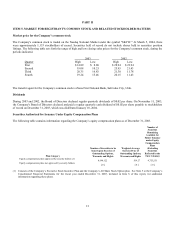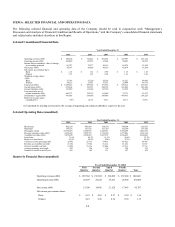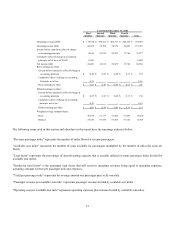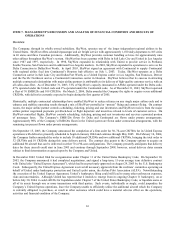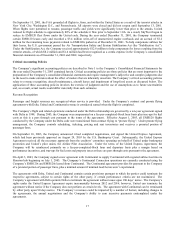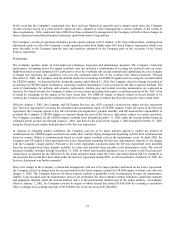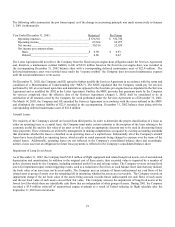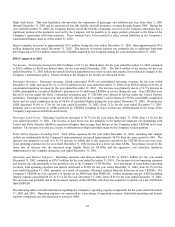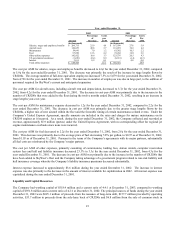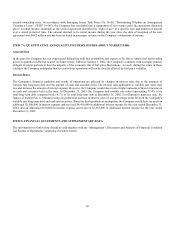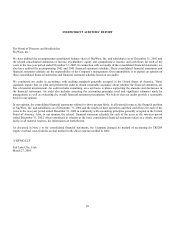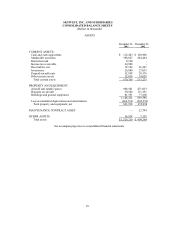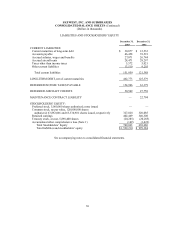SkyWest Airlines 2003 Annual Report Download - page 24
Download and view the complete annual report
Please find page 24 of the 2003 SkyWest Airlines annual report below. You can navigate through the pages in the report by either clicking on the pages listed below, or by using the keyword search tool below to find specific information within the annual report.
The following tables set forth information regarding the Company’s operating and interest expense components for the year ended
December 31, 2003 and 2002. Operating expenses are expressed as a percentage of operating revenues. Individual expense
components are also expressed as cents per ASM.
Year ended December 31,
2003
2002
Amount
Percentage
of
Revenue
Cents
per
ASM
Amount
Percentage
of
Revenue
Cents
Per
ASM
(in thousands) (in thousands)
Salaries, wages and employee benefits $225,545 25.4 3.8 $200,715 25.9 4.6
Aircraft costs 199,355 22.4 3.4 160,853 20.8 3.7
Maintenance 54,151 6.1 0.9 54,041 7.0 1.2
Fuel 149,429 16.8 2.5 97,899 12.6 2.2
Other airline expenses 151,066 17.0 2.6 142,822 18.4 3.3
US government assistance - 0.0 0.0 (1,438) (0.2) 0.0
Interest 9,891 1.1 0.2 3,611 0.5 0.1
Total airline expenses $789,437 13.4 $658,503 15.1
The cost per ASM of salaries, wages and employee benefits decreased to 3.8¢ for the year ended December 31, 2003, compared
to 4.6¢ for the year ended December 31, 2002. The decrease was primarily the result of the increase in stage lengths flown by
CRJ200s. The average number of full-time equivalent employees decreased 2.5% to 4,952 for the year ended December 31,
2003, from 5,079 for the year ended December 31, 2002.
The cost per ASM for aircraft costs, including aircraft rent and depreciation, decreased to 3.4¢ for the year ended December 31,
2003, from 3.7¢ for the year ended December 31, 2002. The decrease in costs per ASM was primarily due to the increase in the
number of CRJ200s that were added to SkyWest’s fleet during year ended December 31, 2003, resulting in an increase in stage
lengths year-over year.
The cost per ASM for maintenance expense decreased to 0.9¢ for the year ended December 31, 2003, compared to 1.2¢ for the
year ended December 31, 2002. The decrease in cost per ASM was primarily attributable to the increase in stage lengths flown
by CRJ200s, a higher mix of new aircraft within SkyWest’s fleet and the favorable timing of certain maintenance-related events.
Under the United Express Agreement, specific amounts are included in the rates and charges for mature maintenance on the
Company’s CRJ200 engines that the Company records as revenue. However, the Company records maintenance expense on its
CRJ200 engines as the maintenance expense is incurred. As a result, during the year ended December 31, 2003, the Company
collected and recorded as revenue, approximately $15.9 million (pretax) under the United Express Agreement, with no
corresponding offset for regional jet engine maintenance overhauls since none were incurred during the year.
The cost per ASM for fuel increased to 2.5¢ for the year ended December 31, 2003, compared to 2.2¢ for the year ended
December 31, 2002. This was primarily due to the average price of fuel increasing 15.5% per gallon, to $1.12 during 2003 from
$0.97 during 2002. Pursuant to the terms of the Company’s agreements with its major partners, substantially all fuel costs are
reimbursed by the Company’s major partners.
The cost per ASM for other expenses, primarily consisting of landing fees, station rentals, computer reservation system fees and
hull and liability insurance, decreased 21.2% to 2.6¢ for the year ended December 31, 2003, from 3.3¢ for the year ended
December 31, 2002. The decrease in cost per ASM was primarily due to the increase in stage lengths flown by CRJ200s, the
Company taking advantage of a government program related to war-risk liability and hull insurance coverage whereby the
Company’s liability insurance premiums decreased substantially, the decision of United to discontinue their prior practice of
billing the Company for access to United’s computer reservation system.
The Emergency War Time Supplemental Appropriations Act of 2003 became effective on May 15, 2003, and the Company
received approximately $6.5 million under the Act. This legislation provides for compensation to domestic airlines based on their
proportional share of passenger security and infrastructure security fees paid, as well as reimbursement for installing fortified
21




